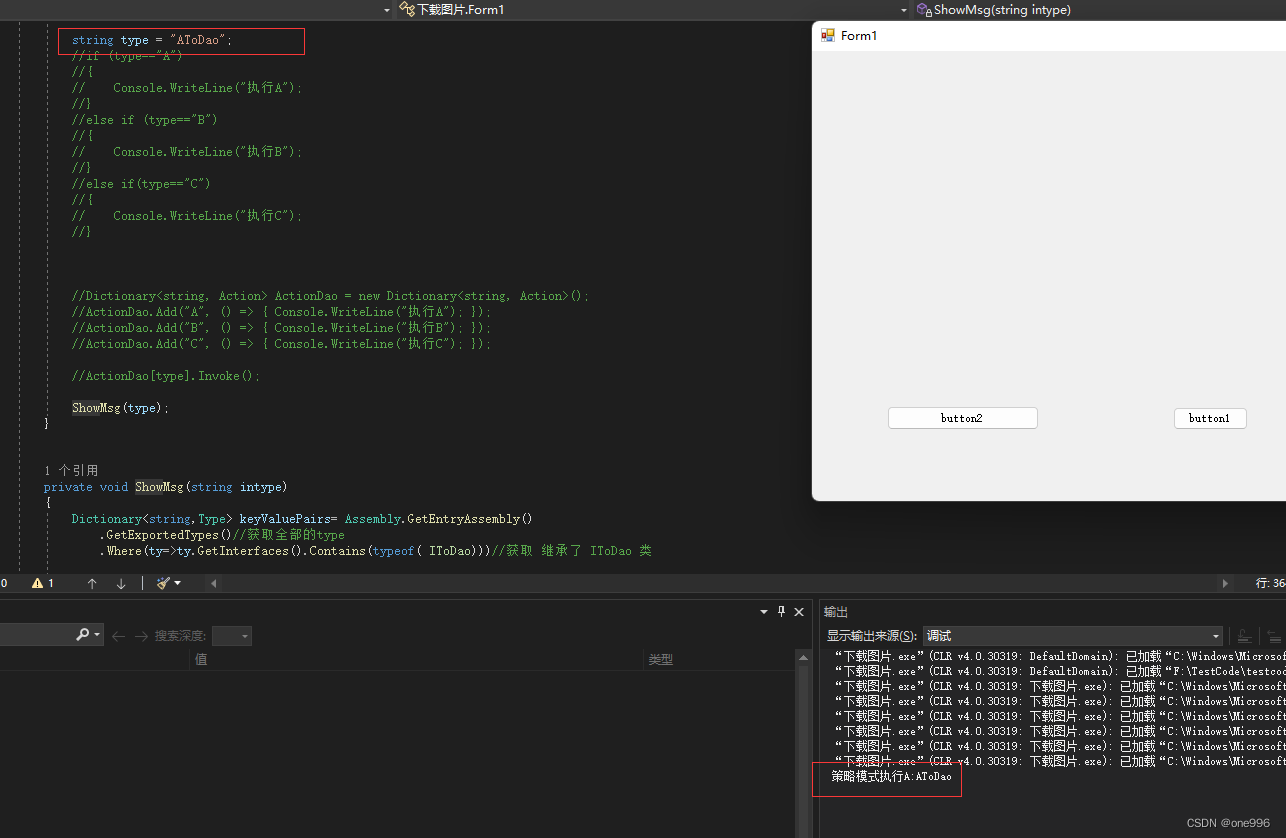if else 是入门最常遇到的一种结构,这种结构简单易懂,深受初学者喜爱。但是 If-Else通常是一个糟糕的选择。
它的可读性差,如果用的太多,会导致结构重构困难。今天我就介绍替代 If-Else的方法。
**
一、字典重构,完全不用If-Else
**
下面是我们最常见的 If-Else实现
string type = "B";
if (type=="A")
{
Console.WriteLine("执行A");
}
else if (type=="B")
{
Console.WriteLine("执行B");
}
else if(type=="C")
{
Console.WriteLine("执行C");
}
可能很多人会喜欢这种方式,可是对于拓展来说,体验并不好。后面如果再增加操作的话,可以考虑重构成字典。
Dictionary<string, Action> ActionDao = new Dictionary<string, Action>();
ActionDao.Add("A", () => { Console.WriteLine("执行A"); });
ActionDao.Add("B", () => { Console.WriteLine("执行B"); });
ActionDao.Add("C", () => { Console.WriteLine("执行C"); });
ActionDao[type].Invoke();
我们把ifelse 重构成Key-Value的模式,执行Action完成需要处理的事情。这种拓展大大的方便阅读和拓展的需要。
二、策略模式,完全不用If-Else
除了这个,我们还可以使用策略模式去实现。不过,策略模式的代码会比较复杂。
1、首先我们需要抽象一个方法出来
public interface IToDao
{
string Show(string val);
}
2、实现接口
public class AToDao : IToDao
{
public string Show(string val)
{
Console.WriteLine(val);
return val;
}
}
public class BToDao : IToDao
{
public string Show(string val)
{
Console.WriteLine(val);
return val;
}
}
public class CToDao : IToDao
{
public string Show(string val)
{
Console.WriteLine(val);
return val;
}
}
3、创建一个特性,这个特性的目的是获取标记实现了抽象接口的实例化
public class DisPlayAttribute:System.Attribute
{
public string Name;
public DisPlayAttribute(string name)
{
Name=name;
}
public string DisPlayShow()
{
return Name;
}
}
4、然后我们给实现了接口的类都加上特性
[DisPlayAttribute("AToDao")]
public class AToDao : IToDao
{
public string Show(string val)
{
Console.WriteLine("策略模式执行A:"+val);
return val;
}
}
[DisPlayAttribute("BToDao")]
public class BToDao : IToDao
{
public string Show(string val)
{
Console.WriteLine("策略模式执行B:"+val);
return val;
}
}
[DisPlayAttribute("CToDao")]
public class CToDao : IToDao
{
public string Show(string val)
{
Console.WriteLine("策略模式执行C:"+val);
return val;
}
}
5、接下来我们就可以通过特性获取到对应的类进行实例化,调用接口方法了,代码如下:
private void ShowMsg(string intype)
{
Dictionary<string,Type> keyValuePairs= Assembly.GetEntryAssembly()
.GetExportedTypes()//获取全部的type
.Where(ty=>ty.GetInterfaces().Contains(typeof( IToDao)))//获取 继承了 IToDao 类
.ToDictionary(ty=>ty.GetCustomAttribute<DisPlayAttribute>().DisPlayShow());//获取 继承了 IToDao 类 通过特性获取类名称
Type type= keyValuePairs[intype];//获取 type
//Type type = Type.GetType(assemblyName + "." + intype);
// 创建类型的一个实例
IToDao toDao = Activator.CreateInstance(type) as IToDao;//获取 type 实例化接口
if (toDao != null)
{
toDao.Show(intype);
}
}
最后看下我们的效果:

总结:简单的逻辑使用IFELSE不影响,但是如果后面还需要拓展,可以使用更高级的写法!字典模式相对简单,也比较容易读懂。我自己也比较喜欢。策略模式优势是拓展性好,但是代码阅读起来会比较困难。因为不知道是哪个地方实现的。可以根据需求,选择不同的实现方式。
参考文档:
https://learn.microsoft.com/zh-cn/dotnet/csharp/programming-guide/concepts/attributes/accessing-attributes-by-using-reflection






















 1320
1320











 被折叠的 条评论
为什么被折叠?
被折叠的 条评论
为什么被折叠?








